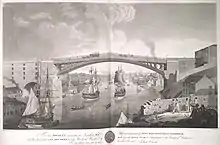Wearmouth Bridge (1796)
The first Wearmouth Bridge was the second major bridge to be made from cast iron. It was considered one of the wonders of the industrial age, and was described by Nikolaus Pevsner as being 'a triumph of the new metallurgy and engineering ingenuity [...] of superb elegance'.[1]
Wearmouth Bridge | |
|---|---|
 Engraving dated 1796 from King George III Topographical Collection | |
| Coordinates | 54°54′36″N 1°22′58″W |
| Characteristics | |
| Design | Single span |
| Material | Cast iron |
| Total length | 240 ft (73 m) |
| History | |
| Designer | Thomas Paine |
| Constructed by | Thomas Wilson |
| Construction cost | £28,000 |
| Opened | 1796 |
| Inaugurated | 9 August 1796 |
| Rebuilt | 1857-1859 |
| Demolished | 1929 |
| Replaced by | Wearmouth Bridge |
| Location | |

| |
Design
The bridge was instigated, sponsored and patented by Rowland Burdon, the Member of Parliament for County Durham, and built under the direction of Thomas Wilson, who designed its architectural features.[2]
It was the second iron bridge built after the famous span at Ironbridge, but was over twice as long with a nominal span of 240 ft (73 m), and only three-quarters the weight. Indeed, at the time of building, it was the biggest single-span bridge in the world (72 m), matching the collapsed Trezzo Bridge.[3]
The decision to use cast iron was strongly influenced by Thomas Paine, who had constructed a demonstation cast iron span of comparable length in Paddington in 1789, and had submitted models and designs for Wearmouth. [4] [5]
Construction
_under_construction.jpg.webp)
The foundation stone was laid in September 1793.
It is possible that two of the six main ribs used in the Wearmouth bridge, were created from the actual ribs used by Paine in his prototype, which had been returned to the Foundry in Rotherham where the ribs of both bridges were cast.[6]
The bridge was opened in 1796.
Impact
According to the plaque on the current bridge, its construction "proved to be a catalyst for the growth of Sunderland," since access between Monkwearmouth and Bishopwearmouth had previously only been by ferry, with the nearest bridge at Chester-le-Street.
Operation
It opened to traffic on 9 August 1796, having cost a total of about £28,000.[7]
There was originally a toll for traffic and pedestrians, although tolls for pedestrians were abolished in 1846.
1805 repair
In 1805 the bridge had to be repaired after heat from the sun caused some of the cross tubes to fall out.[8]
1857 reconstruction
.jpg.webp)
From 1857 to 1859 it was reconstructed by Robert Stephenson, who stripped the bridge back to its six iron ribs and levelled the roadway by raising the abutments. The bridge was reopened in March 1859, with the toll completely abolished in 1885.[7]
Further reading
- "Engineering Timelines - Wearmouth Bridge (1796), site of". www.engineering-timelines.com. Retrieved 2020-09-23.
References
- Pevsner, Nikolaus; Williamson, Elizabeth (1983). The Buildings of England: County Durham (2nd ed.). London: Penguin.
- Tyrrell, Henry Grattan : "History of Bridge Engineering", pp 153-154, 1911
- Leonardo Fernández Troyano: Bridge Engineering. A Global Perspective, Thomas Telford Publishing, London 2003, ISBN 0-7277-3215-3, p.49
- "Wearmouth Bridge (1796), site of". Retrieved 25 September 2020.
- "The Wearmouth Bridge". Seagull City: Sunderland's Literary and Cultural Heritage. Retrieved 25 September 2020.
- "Thomas Paine & Sunderland Bridge". NorthEastLore. Retrieved 25 September 2020.
- "Sunderland Wearmouth Bridge". Wearside Online. Archived from the original on 2011-11-27. Retrieved 2006-09-24.
- "LOCAL STUDIES CENTRE FACT SHEET NUMBER 7: The Wearmouth Bridge". Local Studies Centre collection, Sunderland Public Library Service. Archived from the original on 7 August 2011. Retrieved 30 January 2011.
| Wikimedia Commons has media related to Wearmouth Bridge (1796). |